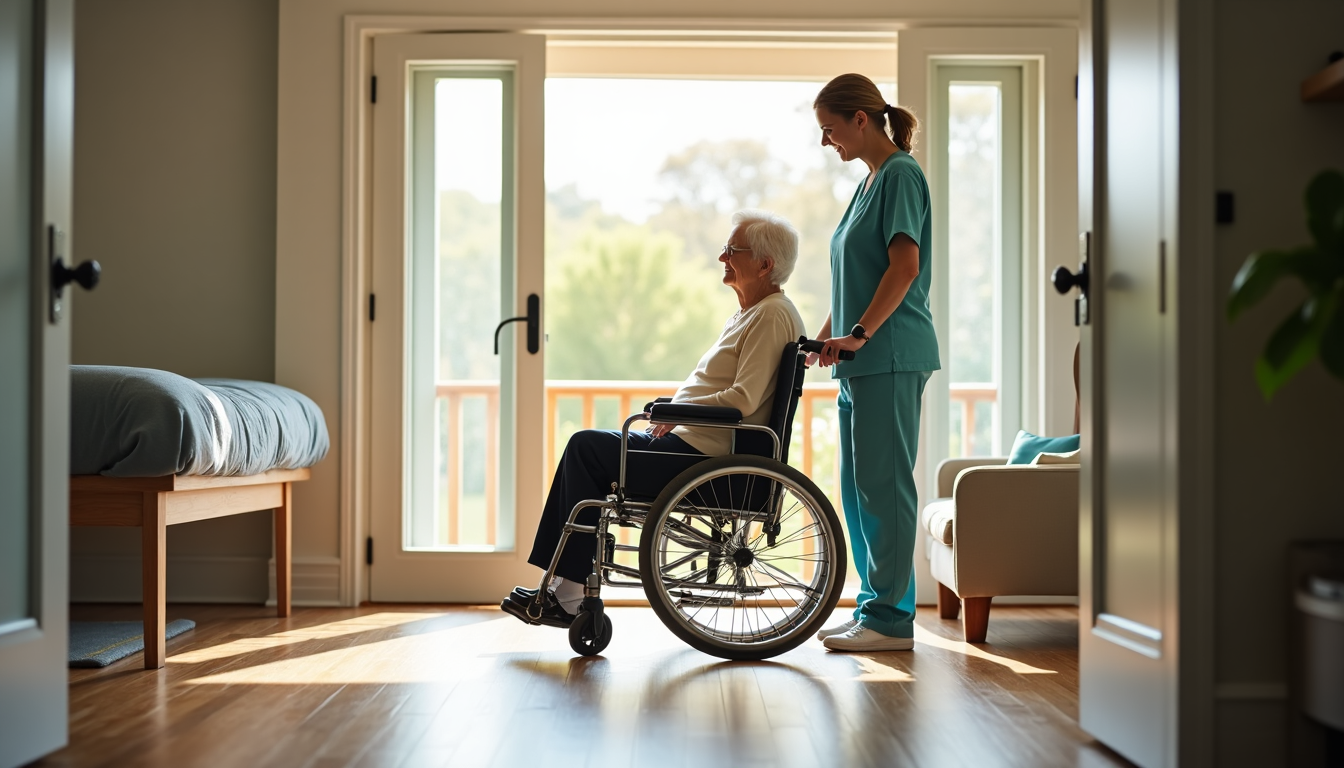About 61 million adults in the United States have a disability, and this number increases by a lot among seniors aged 65 and above.
Many seniors feel lost when dealing with disability assistance programs. The options seem endless – from Social Security benefits to home modification grants. Most eligible seniors miss out on these benefits because they don’t know the first step to take.
This detailed guide will help you understand support options for disabled seniors. You’ll learn about every major assistance program, benefit option, and support resource at federal, state, and local levels. Looking for financial aid, healthcare support, or home modification assistance? We’ll point you directly to the help you need.
Let’s find out which support programs match your needs and explore your options together.
Understanding Available Support Programs
Let us guide you through the disability support programs available to seniors. Our goal is to simplify these programs into clear categories that match your needs.
Federal vs State Disability Benefits
Federal and state programs create a complete support system for disabled seniors. Social Security Disability Insurance (SSDI) and Medicare provide nationwide coverage, while state-specific programs add extra support layers. Here’s what matters:
- Federal Programs:
- Benefits remain consistent nationwide
- Social Security, Medicare, and federal housing assistance are included
- Benefit amounts tend to be larger
- Eligibility requirements follow standard rules
- State Programs:
- Benefits differ by location
- Extra support adds to federal benefits
- Eligibility rules show more flexibility
- Emergency assistance and additional services are available
Income-Based vs Needs-Based Programs
The distinction between income-based and needs-based programs is vital to get the right support. Income-based programs like SSDI need your work history and past tax contributions. Needs-based programs like Supplemental Security Income (SSI) look at your current financial status and immediate requirements.
Emergency Assistance Options
Quick help exists when you need it most. Emergency assistance programs deliver immediate support through:
- Temporary Assistance for Needy Families (TANF)
- Emergency housing assistance
- Crisis intervention services
- State-specific emergency funds
Seniors facing critical situations can access accelerated processing in many programs. To cite an instance, some Social Security claims take days instead of the usual 65-day period in urgent cases.
A benefits counselor or social worker can help you combine multiple programs for maximum support. Program requirements and benefits change over time, so professional guidance is valuable.
Navigating Financial Assistance
Financial assistance programs help seniors with disabilities maintain their independence and quality of life. Here’s a guide to the most important benefits and coverage options available to you.
Social Security Disability Benefits
Your Social Security benefits play a vital role in securing financial stability. In 2024, the Supplemental Security Income (SSI) program provides up to $943 monthly for individuals and $1,415 for couples. You must meet these requirements to qualify:
- Have limited income (under $2,000 in assets for individuals)
- Be age 65 or older, blind, or disabled
- Be a U.S. resident or meet specific citizenship requirements
- Apply for other potential benefits you may be eligible for
Medicare and Medicaid Coverage
Medicare and Medicaid can work together to provide complete healthcare coverage. You become eligible for Medicare coverage after receiving Social Security Disability benefits for 24 months. People with ALS or End-Stage Renal Disease can receive immediate coverage.
Medicaid provides additional support through various pathways. You may qualify if your income is at or below 74% of the federal poverty level. Many states have special programs that allow working individuals with disabilities to keep their Medicaid coverage even with higher income levels.
Private Insurance Options
Private insurance adds an extra layer of security beyond public benefits. Disability insurance through employer-sponsored plans comes in two types:
- Short-term disability: Provides benefits for less than one year
- Long-term disability: Can extend coverage up to age 65 or beyond
You should consider combining multiple programs to create a complete financial safety net. Note that benefit amounts and eligibility criteria change yearly, so verify current information through official sources.
Home Modification and Accessibility Grants
You can make your home more accessible without emptying your bank account. We researched many home modification programs and grants that help disabled seniors create safer living spaces. Here are the funding sources that can help you modify your home to improve accessibility.
Federal Housing Assistance Programs
The U.S. Department of Housing and Urban Development (HUD) runs several programs that help disabled seniors modify their homes. The Section 811 Supportive Housing program helps you get funding for home modifications and renovations. This program provides:
- Interest-free capital advances to nonprofit organizations
- Project rental assistance for housing developments
- Support for accessibility modifications in existing homes
- Ongoing maintenance assistance
Veterans can get up to $117,014 (FY 2024) through the VA’s Specially Adapted Housing (SAH) grant if they have qualifying service-related disabilities.
State-Level Home Modification Resources
State housing agencies provide extra support through programs of all sizes. The Home Accessibility Program (HAP) provides funding through local government and non-profit organizations to help seniors stay in their homes. These programs typically cover:
Essential Modifications:
- Ramp installations
- Doorway widening
- Bathroom accessibility updates
- Kitchen modifications
- Safety equipment installation
Non-Profit Organization Support
We work together with several non-profit organizations that are a great way to get assistance for home modifications. Habitat for Humanity’s Aging in Place program teams up with human services organizations to assess individual needs and provide critical home repairs. Their services include:
- Home safety evaluations
- Installation of grab bars and handrails
- Wheelchair ramp construction
- Bathroom modifications
- Door lever installations
The Rebuilding Together program connects you with volunteers who make homes safer and more livable for low-income seniors. These organizations often provide services at reduced costs or free of charge if you qualify.
Note that you can combine many of these programs to maximize your benefits. A housing counselor can help identify which programs best suit your specific needs and circumstances.
Healthcare and Medical Equipment Support
Quality of life improves substantially for disabled seniors who can access proper medical equipment and healthcare support. This piece shows you the best programs and resources that help you get the care and equipment you need.
Medical Equipment Coverage Programs
Medicare Part B gives complete coverage for Durable Medical Equipment (DME) when your Medicare-enrolled doctor prescribes it. You’ll typically pay 20% of the Medicare-approved amount after meeting your deductible. The coverage includes:
- Wheelchairs and scooters
- Hospital beds and patient lifts
- Walkers, canes, and crutches
- Blood sugar meters and test strips
- Oxygen equipment and accessories
State-based assistance programs provide extra support through Assistive Technology Projects and Device Loan Programs. These programs let you test equipment before buying and may offer low-interest loans or grants to acquire medical equipment.
Prescription Assistance Resources
Medication costs can feel overwhelming. The Medicare Extra Help program helps you save money on prescription drugs. Qualified seniors in 2024 pay no more than:
- $4.50 for generic medications
- $11.20 for brand-name drugs
The California Rx Card and similar state programs give you free prescription assistance with savings up to 80% on some medications. These programs are accessible to all residents whatever their income or insurance status.
Healthcare Navigation Services
Our healthcare navigation professionals coordinate care in health systems of all sizes to ensure you get integrated support for both physical and mental health needs. These services are a great way to get help especially when you have:
- Eligibility for both Medicare and Medicaid
- Multiple chronic conditions to manage
- Long-term care service needs
Navigation services include face-to-face meetings, service delivery monitoring, and coordination with healthcare providers to ensure complete care. This tailored approach reduces gaps in care and leads to better health outcomes for disabled seniors.
Conclusion
Support systems for disabled seniors go way beyond simple assistance programs. You can access essential benefits through multiple pathways, from Social Security disability payments to home modification grants and medical equipment coverage.
Valuable benefits slip through seniors’ fingers because they don’t know these programs exist. Take time to review each program we’ve covered to find ones that match your needs. A complete care package emerges when you combine different support options.
Your rights and available resources hold the key to success. Start with federal programs like SSDI and Medicare, then look into state-specific benefits that build on this foundation. Medical equipment support, prescription assistance, and home modification programs blend together to help you stay independent and maintain your quality of life.
Getting disability assistance might look complicated, but you won’t walk this path alone. Benefits counselors and healthcare guides can make the process easier and help you get every benefit you qualify for. These programs could transform your life – take the first step today.
FAQs
- What is the $300,000 Senior Assistance Program in California? The $300,000 Senior Assistance Program in California is designed for residents who are 65 years or older, individuals who are blind or have a disability, and those living in nursing homes or intermediate care facilities.
- What federal program assists elderly and disabled individuals? The Supplemental Security Income/State Supplementary Payment (SSI/SSP) program is a federal initiative providing income support to eligible individuals who are aged 65 or older, blind, or disabled. This program also extends benefits to qualified blind or disabled children.
- What are the most commonly requested support services for the elderly? Seniors most frequently need services such as personal care, medication management, nutrition and meal support, mobility and transportation, healthcare, money management, safety and security measures, and opportunities for social interaction.
- What types of assistance are available for seniors in California? Seniors in California can access a variety of services including caregiver assistance, home help, adult day health care, respite care, assisted and general transportation, legal aid, telephone support, care management, and general information and assistance.












